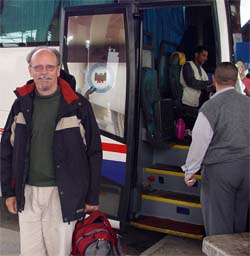 Fr
Khoren and Dikran, the caretaker at the Armenian Church, take me to the
"Pullman" bus station for my return trip to Aleppo. It is interesting to travel
in the daylight hours for the return trip and to see all of the countryside I
missed coming down to Der ez-Zur in the night, about 30 hours earlier. There are
very few stretches of bare wilderness along the way, most of the land bordering
the Euphrates is either used for sheep and goat husbandry, or under
cultivation.
Fr
Khoren and Dikran, the caretaker at the Armenian Church, take me to the
"Pullman" bus station for my return trip to Aleppo. It is interesting to travel
in the daylight hours for the return trip and to see all of the countryside I
missed coming down to Der ez-Zur in the night, about 30 hours earlier. There are
very few stretches of bare wilderness along the way, most of the land bordering
the Euphrates is either used for sheep and goat husbandry, or under
cultivation.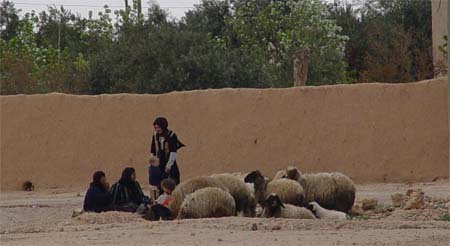
A major dam project on the Euphrates to generate hydro-electric power and to
control the distribution of water for irrigation in the region was supposed to
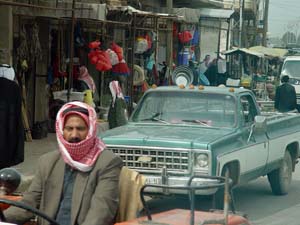 be the
crowning achievement of the elder President Assad administration. All went well
until the Turks decided to build a dam of their own, further upstream, and now
control the flow of water. The Moslem Sabbath is over and the towns and villages
we see along the way are all busy with morning traffic, shoppers and a full away
of merchandise on display.
be the
crowning achievement of the elder President Assad administration. All went well
until the Turks decided to build a dam of their own, further upstream, and now
control the flow of water. The Moslem Sabbath is over and the towns and villages
we see along the way are all busy with morning traffic, shoppers and a full away
of merchandise on display.
Fr. Zareh and Fr. Datev meet me at the bus station and deliver me to the Prelacy. I take a couple of hours in the afternoon to lay low and rest after four very full days of travel and sight seeing.
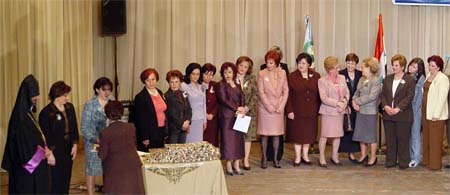
After Evening Prayer at the Cathedral, I join Bishop Shahan and Fr. Zareh,
his chaplain, for a ride in the Prelate's chauffeured Mercedes to attend an
award presentation in the large auditorium next door to St. Mary's Armenian
Orthodox Church. The evening event is
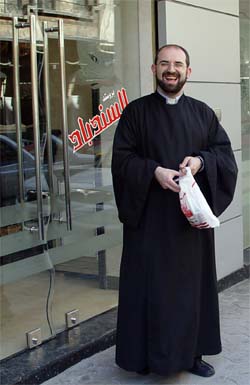 hosted by a women's group active in the diocese,
an organisation similar to the Anglican Church Women in Canada, and awards are
presented to women who have been active with traditional needlework projects and
other efforts to raise funds for a variety of charitable projects in Aleppo and
among the poor in Armenia.
hosted by a women's group active in the diocese,
an organisation similar to the Anglican Church Women in Canada, and awards are
presented to women who have been active with traditional needlework projects and
other efforts to raise funds for a variety of charitable projects in Aleppo and
among the poor in Armenia.
Following the ceremony, I continue on with Fr. Zareh to visit a few Armenian
households. First we stop to visit Fr. Zareh's parents. His father (pictured
here) is in his early eighties and has only recently retired from active
ministry as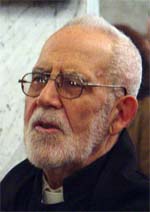 a parish priest, passing along the families under his pastoral
responsibility to his son. We next stop in on one of these families for a brief
visit. Fr. Zareh likes to touch base with parishoners on their saint's day (name
day), and the father of the household we visit is named Manoog, and his feast
day is tomorrow — the feast of the 40 Martyrs (Karasoun Manoog). After the visit
we pick up a few fresh falafel sandwiches from the "best falafel sandwich bar"
in Aleppo, and Fr. Zareh takes me to visit his own home and to meet his wife
Aline and Hamo, their delightful 2 year old son. All-in-all it makes for a very
full evening, and I am extremely thankful for this opportunity to visit
a parish priest, passing along the families under his pastoral
responsibility to his son. We next stop in on one of these families for a brief
visit. Fr. Zareh likes to touch base with parishoners on their saint's day (name
day), and the father of the household we visit is named Manoog, and his feast
day is tomorrow — the feast of the 40 Martyrs (Karasoun Manoog). After the visit
we pick up a few fresh falafel sandwiches from the "best falafel sandwich bar"
in Aleppo, and Fr. Zareh takes me to visit his own home and to meet his wife
Aline and Hamo, their delightful 2 year old son. All-in-all it makes for a very
full evening, and I am extremely thankful for this opportunity to visit
 Armenian
families and their homes.
Armenian
families and their homes.
The next morning is a big day at the cathedral. The cathedral is dedicated to the memory of the 40 Martyrs of Sebastia and today, the feast of the martyrs, is the cathedral's patronal feast. During a purge of Christians from the ranks of the Roman legions, 40 young elite soldiers in Sebastia (Asia Minor) were identified as Christians and martyred when they refused to renounce their faith. The Armenian Church keeps this feast on the weekend following the median point of Lent. Normally the feast takes place on Saturday, but the celebration is transferred to the Sunday for the many churches in the Armenian world dedicated to the 40 Martyrs.
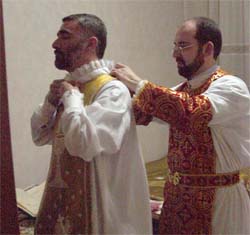 God
is very good to me in that my travel should coincide with this feast, entirely
unplanned on my part. Not only do I have an opportunity to see the Cathedral
with the curtain in front of the altar opened for the occasion, but it is also
my host, Bishop Shahan who is the celebrant for the festal service. Shahan
Serpazan very kindly allows me to observe and take photos while Fr. Zareh
assists him in vesting for the Divine Liturgy. The vestments are basically the
same as for a priest,
God
is very good to me in that my travel should coincide with this feast, entirely
unplanned on my part. Not only do I have an opportunity to see the Cathedral
with the curtain in front of the altar opened for the occasion, but it is also
my host, Bishop Shahan who is the celebrant for the festal service. Shahan
Serpazan very kindly allows me to observe and take photos while Fr. Zareh
assists him in vesting for the Divine Liturgy. The vestments are basically the
same as for a priest,
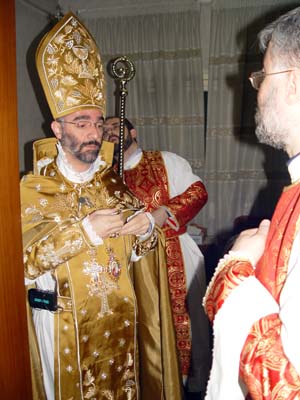 but over these is worn a large liturgical band that raps
around the shoulders with two bands attached by hooks running down the bishop's
front and back. called the Emiporon (the pallium). The bishop also wears neck
chains bearing his cross and oval episcopal medallion. His episcopal ring is
worn on the small finger of the right hand; and, in the Armenian tradition, he
wears a tall mitre — high pointed bishop's hat — the two rear tassels of the
western mitre are attached to the back of the bishop's high stiff collar or
amice in Armenian tradition. The bishop also caries a crosier or episcopal staff
and a hand cross.
but over these is worn a large liturgical band that raps
around the shoulders with two bands attached by hooks running down the bishop's
front and back. called the Emiporon (the pallium). The bishop also wears neck
chains bearing his cross and oval episcopal medallion. His episcopal ring is
worn on the small finger of the right hand; and, in the Armenian tradition, he
wears a tall mitre — high pointed bishop's hat — the two rear tassels of the
western mitre are attached to the back of the bishop's high stiff collar or
amice in Armenian tradition. The bishop also caries a crosier or episcopal staff
and a hand cross.
Once robed Bishop Shahan is greeted at the door of his residence by clergy, deacons, choir and acolytes, and the procession begins leading him to the Cathedral for the liturgy.
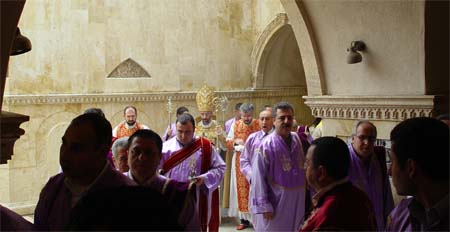
The Bishop is accompanied by two thurifers (incense bearers) — pictured below with their red deacon stoles across their chests. When ever the bishop turns toward the people, the thurifers swing their thuribles back and forth, and turn out toward the people with timed precision, giving a very powerful air of importance to the episcopal office. Click here to see a short film from the beginning of the Badarak (Divine Liturgy).
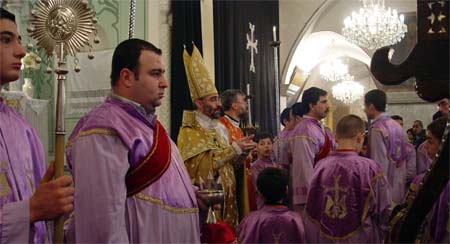
The seven members of the administrative council for the diocese are present
for the celebration of the Cathedral's patronal feast and also attend similar
events in other churches when the bishop is celebrant. Pictured, below right,
Baron Levon Zikka and Dr. Manuel Iskanderian, responsible respectively for
planning and education in the diocese, with whom I had the pleasure of sharing
lunch on Thursday.
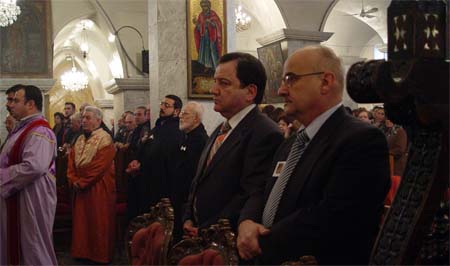
Dr. Iskanderian is the co-chair, with Bishop Shahan of the administrative council of the diocese. There is another executive council in the diocese responsible for pastoral ministry and made up of seven priests. The two councils, administrative and pastoral, are responsibile for the leadership of the diocese under the oversight of the bishop.
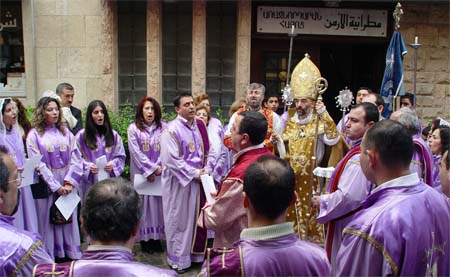
Following a magnificent celebration of the Badarak (the Divine Liturgy) the clergy, deacons, acolytes and choir escort Bishop Shahan back to the Prelacy, they pause here to sing the national anthem for the Catholicosate of the Great House of Cilicia; and Shahan Serpazan gives the episcopal blessing before entering his residence.
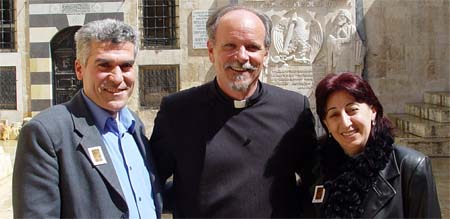
After the service, I meet the parents of one of the deacon's at the seminary in Bikfaya, Deacon Berj (picture right, below) a leader of the seminary choir and a very fine tenor himself. After meeting his parents, I now understand why Deacon Berj is so pleasant and kind — he comes by it honestly, as we say.
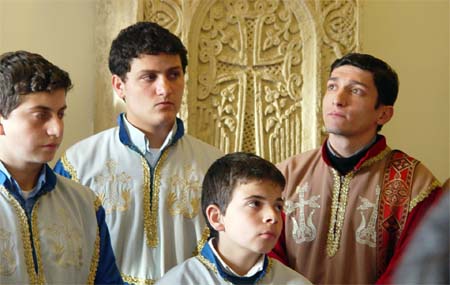
I return to Antelias on the 11 p.m. bus which picks up its Armenian passengers (about a third of the bus) at a corner not far from the Prelacy before going on to the main bus station. The ride goes smoothly, once again, Shahan Serpazan has reserved two seats (costing less that $20 US to do so!) for the 7 hour journey so I am able to spread out and get some rest after a very full and simply fascinating visit with possibly the friendliest Armenians in the whole wide world, the Armenians of Syria!







